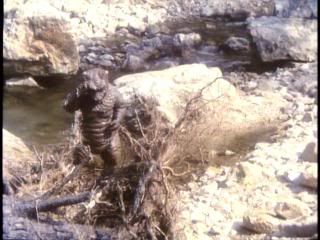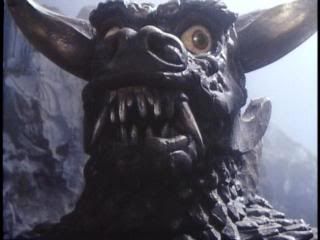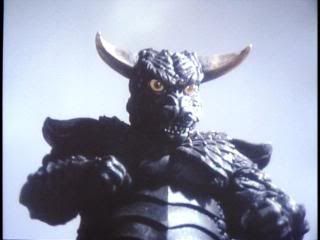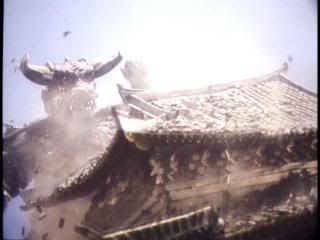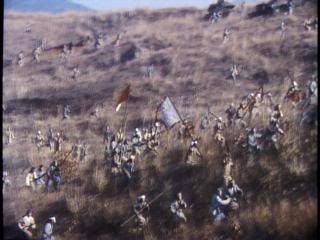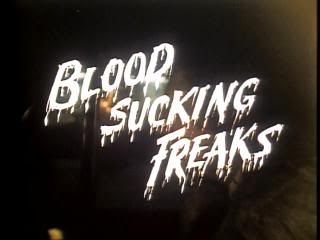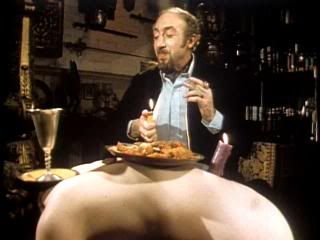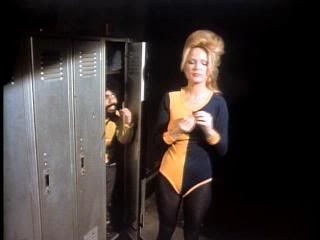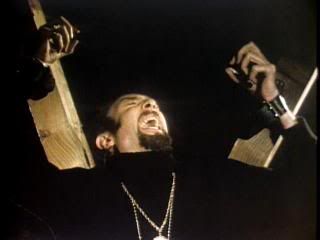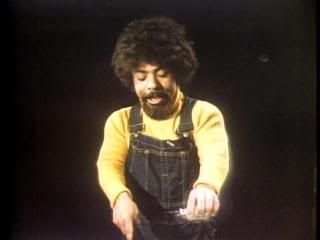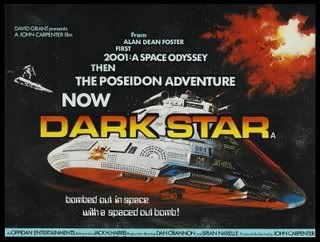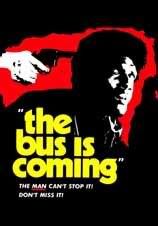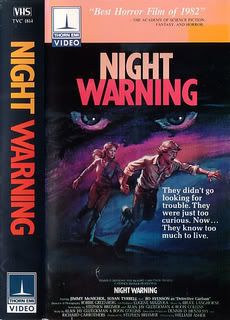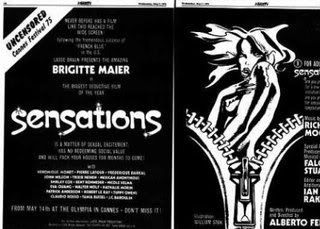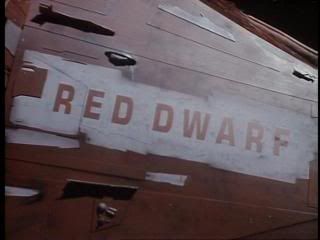
A twenty year old cult phenomenon at this point, Red Dwarf began in 1988 as the long gestating brainchild of Spitting Image writers Rob Grant and Doug Naylor. Riding the wave of the alternative British comedy programs of the 1980s, along with influence from John Carpenter's irreverent Dark Star and the long tradition of English science fiction (Blake's 7, Dr. Who), the show showed that melding sometimes broad comedy and hard sci-fi could be done in a sitcom format. The first season is at times rather inconsistent, but it's clear even now that the creators were onto something.
The six episodes of the first series are:
1) The End - Lister is sentence to 18 months in stasis (a sort of suspended animation) for keeping a cat on the ship, but awakens to find it's three million years later and the entire crew has been killed by a radiation leak. His only company is the ship's computer Holly (Norman Lovett), a human/cat hybrid that evolved from his pet (Danny John-Jules), and the holographic representation of his former roommate: the uptight, bureaucratic Rimmer (Chris Barrie).

The first episode quickly introduces the viewer to the premise of the show and rather smoothly brings us into it's futuristic world. The Odd Couple dynamic of Lister and Rimmer may seem like a sitcom cliche, but both actors take great joy in jumping into their roles and their interplay (and the deft script) makes for very entertaining viewing.
The six episodes of the first series are:
1) The End - Lister is sentence to 18 months in stasis (a sort of suspended animation) for keeping a cat on the ship, but awakens to find it's three million years later and the entire crew has been killed by a radiation leak. His only company is the ship's computer Holly (Norman Lovett), a human/cat hybrid that evolved from his pet (Danny John-Jules), and the holographic representation of his former roommate: the uptight, bureaucratic Rimmer (Chris Barrie).

2) Future Echoes - As Lister debates returning to stasis while the ship heads for earth, the crew begins to experience strange time anomalies. Discovering it's the result of them traveling faster than the speed of light, Rimmer appears to witness a future vision of Lister being killed and Lister has to find a way to avoid this eventuality.
Mixing hard science fiction with sitcom style would become what Red Dwarf would be known for, and they jump right into the rather murky territory of time anomalies in the series' second episode. Featuring some rather ambitious special effects for the time, this is one of the stronger efforts from the first season.
3) Balance Of Power - Frustrated with Rimmer's unwillingness to let him date the hologram of former ship-mate Kristine Kochanski, Lister decides to get his chef certificate so he will outrank him. Rimmer, of course, attempts to stop this from happening by any means necessary.
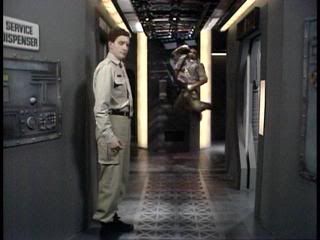
A rather standard episode, though it gives plenty of opportunity for the two leads to insult each other with the terms (Smeghead, gimboid, goit) the series became known for. Fun, but the episode feels a bit like a throwaway, which is rather disappointing when you're talking about a brief, six-episode series.
4) Waiting For God - Lister discovers that he is considered God by Cat's people and becomes distressed when he reads about the the violence that has been carried out in hi name during his time in stasis. Meanwhile, Rimmer becomes obsessed with a (unknown to him) garbage pod brought onto the ship and mistakenly believes that it may contain alien life.

The main story of this episode is an interesting, though heavy handed, commentary on religion; a rather heady topic for a sitcom. It was nice to see a bit of development of the history of the cat people (the Felis sapiens), but it seemed like the writers were still trying to find their feet with The Cat as a character at this point. Rimmer's discovery of the pod's actual purpose is classic, however.
5) Confidence And Paranoia - After Lister contracts a mutated for of Paranoia, his dreams begin to manifest in solid form. This includes living personifications of his confidence (played by Scottish talk show host Craig Ferguson) and paranoia (Lee Cornes). While at first pleased with the company, Lister soon finds that unbridled confidence comes with a dangerous price.
5) Confidence And Paranoia - After Lister contracts a mutated for of Paranoia, his dreams begin to manifest in solid form. This includes living personifications of his confidence (played by Scottish talk show host Craig Ferguson) and paranoia (Lee Cornes). While at first pleased with the company, Lister soon finds that unbridled confidence comes with a dangerous price.
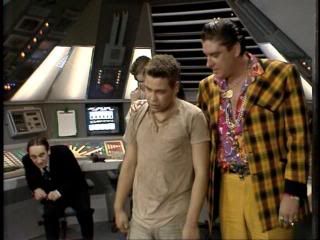
Likely the weakest episode of the first series, though it's certainly interesting to see a pre-fame Craig Ferguson and it does include quite an impressive body explosion at the end. It's rather heady stuff as a whole, but the episode doesn't really have enough time to properly explore the idea.
6) Me² - After the events of the previous episode, Lister finds himself having to deal with two holographic Rimmers aboard the ship. While at first they get along perfectly, they soon begin to despise each other. Eventually it's decided that only one can stay, but how will they choose?
6) Me² - After the events of the previous episode, Lister finds himself having to deal with two holographic Rimmers aboard the ship. While at first they get along perfectly, they soon begin to despise each other. Eventually it's decided that only one can stay, but how will they choose?
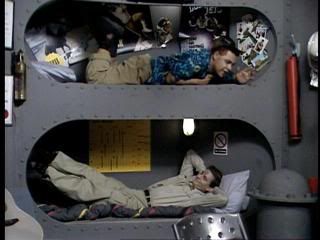
A strong final episode of the first series, with the idea of Rimmer's perfect copy being intolerably irritating taken to its logical extreme. This episode also features Lister watching the tape of Rimmer's death and discovering that his final words were "gazpacho soup". The explanation of this (with a fun Citizen Kane reference) is actually a reference to an actual incident with Rob Grant and Doug Naylor where they were unaware that "gazpacho soup" was served cold.
There have been a number of DVD releases of Red Dwarf, but I watched the BBC Warner DVD of the first series which includes the episodes as broadcast. These episodes (as well as those from series two and three) were later remastered with different special effects and editing for alternate broadcasts and DVD release. The full screen transfer looks strong, though a bit on the dull side since almost every set is painted a rather drab gray.
There are commentaries on every episode by Craig Charles, Chris Barrie, Norman Lovett, and Danny John-Jules. The first episode also features a bonus commentary by Rob Grant, Doug Naylor, and Ed Bye. It's almost a shame that this wasn't reversed as the Grant/Naylor/Bye track on episode one is wonderfully informative. It details briefly what influenced the show, the casting, and where the names of the characters came from amongst other trivia. While the cast commentaries are fun, it's obvious that the actors haven't seen the episodes in a long time and spend more time watching and laughing at the lines than revealing any information.
There have been a number of DVD releases of Red Dwarf, but I watched the BBC Warner DVD of the first series which includes the episodes as broadcast. These episodes (as well as those from series two and three) were later remastered with different special effects and editing for alternate broadcasts and DVD release. The full screen transfer looks strong, though a bit on the dull side since almost every set is painted a rather drab gray.
There are commentaries on every episode by Craig Charles, Chris Barrie, Norman Lovett, and Danny John-Jules. The first episode also features a bonus commentary by Rob Grant, Doug Naylor, and Ed Bye. It's almost a shame that this wasn't reversed as the Grant/Naylor/Bye track on episode one is wonderfully informative. It details briefly what influenced the show, the casting, and where the names of the characters came from amongst other trivia. While the cast commentaries are fun, it's obvious that the actors haven't seen the episodes in a long time and spend more time watching and laughing at the lines than revealing any information.

There is talk of new episodes of Red Dwarf being filmed this year to be shown in 2009, and it's tremendous that the show remains so fresh after it's original broadcast. It's unlikely that anyone would argue that the first season is the best, but it's a strong introduction to the seven series (at this point) that have been produced. Strongly recommended for fans of British humor or science fiction.


